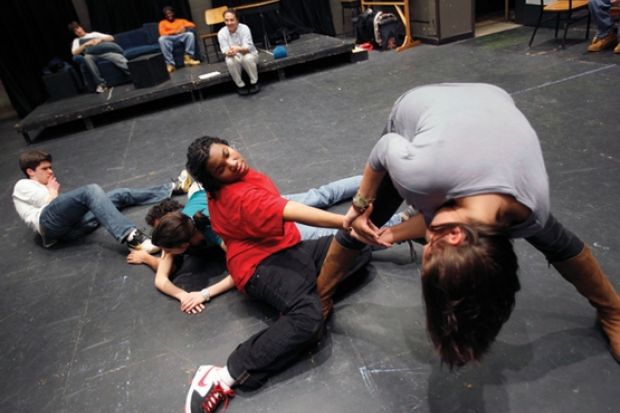Source: Alamy
Joint effort: the end of Aimhigher has meant that worthy efforts to promote university study among pupils from families with no history of university study lack cohesion, say critics
Anton Stevens made his first visit to Brunel University at the age of 12.
Over the next four years, he would travel 90 minutes across London every Saturday from his home in Tottenham to be taught by volunteer students and lecturers at the institution’s campus in Uxbridge.
Despite his love of lazy Saturday morning lie-ins, he did not miss a single session during his time with the university’s Urban Scholars programme, which targets bright but underachieving pupils in deprived areas.
“I have to thank my parents for their old-fashioned Jamaican discipline in getting me to Brunel every week,” said the student, now in the final year of a mathematics course at the university. “Neither of them had been to university, but they were so proud that I had been selected as someone who could make it there.
“My parents would tell all their friends about their son going to university and that forced me to commit and work harder so I could get the grades I needed. Brunel also provided some very nice lunches, so I always looked forward to them, too!”
The Urban Scholars scheme and similar “gifted and talented” university projects often produce heartwarming tales such as this. But such resource-heavy, multi-year initiatives can accommodate only limited numbers of participants.
Now in its 12th year, Urban Scholars has grown from just 20 students in 2000 to 600 children - a cohort set to reach 1,200 within the next four years.
No small achievement, but even if every one of London’s 40-plus higher education institutions were to replicate the same numbers on their outreach schemes, they would still reach only a tiny proportion of the capital’s schoolchildren.
Schools in areas not served by a local university are likely to find access to such schemes even more limited, with many lucky to have had a single visit from a higher education representative.
“If you are a child in a coastal or rural area you will suffer, because why would a university spend their time and money going out to you when they could reach local children more easily?” said Neil Harrison, senior research fellow in education at the University of the West of England. “Many universities appear to be focusing on a small (number) of students to hit their access agreements, but that means rural areas are left out.”
Fragmented state
The lack of a coordinated network of nationwide university outreach schemes has prompted widespread concern since the Aimhigher programme was ended by the government last year.
Graeme Atherton, director of AccessHE, which coordinates outreach activities by London universities, said he believed that a “postcode lottery” meant many children were not getting the advice they needed.
A study he published last month, Riding the Storm, shows most schools outside the UK’s large metropolises are unlikely to have contacts within a network of institutions, in contrast to the state of affairs with Aimhigher. Instead they must develop their own links with individual universities - a fragmented approach that risks leaving some children without any contact with higher education institutions at all.
While individual universities will reach many potential applicants, the failure to replace Aimhigher’s national and regional efforts means that there is a serious gap in the guidance available to thousands of teenagers, said Dr Atherton.
“Where there was organised, systematic collaboration worth £100 million in 2010-11, there is now only £3 million of outreach activity,” he said.
Alan Milburn, the government’s social mobility tsar, suggested in University Challenge: How Higher Education Can Advance Social Mobility, a report published in October, that more joined-up thinking was needed on outreach spending, which he argued should also increase significantly.
However, relatively few universities have signed up to collaborative partnerships, leaving social enterprises, businesses and charities to take up the challenge.
Established players such as Brightside, the Sutton Trust and the Villiers Park Educational Trust have been joined by entrants such as The Brilliant Club. A social enterprise set up by two graduates of the Teach First programme, it trains PhD students to mentor children in deprived areas.
In this new “mixed economy” for outreach, Push, a company that publishes university guides for students, has this year organised 400 visits to schools to talk to pupils about how they might choose degree courses.
“If you come from a background where your parents…don’t talk to you about higher education, it is difficult to pick out the important things when choosing a course,” said Push co-founder Jonny Rich during a visit to Highbury Grove School in Islington.
During his talk, it was clear that some pupils had clearly mapped-out futures, but others admitted giving little thought to further study.
Mr Rich said that university admissions officers might visit schools to give advice about the applications process, “but it’s hard for them to talk more widely about…types of university beyond their own”.
“We also visit schools that universities would not think about visiting. For instance, there is a school on the Isle of Sheppey off the coast of Kent that we visit that otherwise wouldn’t [see] a higher education representative,” Mr Rich added.
“If you live in Berwick or Truro, you are in just as much need of advice and guidance as someone living in London. In fact, you probably need more because you can’t visit 40 or so universities on your Tube pass.”
The talks by Push are sponsored by various charities and businesses - the Highbury Grove visit was paid for by Bestcourse4me, the website set up by software magnate and education philanthropist Steve Edwards.
But they are expensive to run: the cost per outreach visit under Aimhigher was around £1,600 once administration, training and salary expenses were included.
Mr Rich said he believed he could do it more cheaply, but not significantly so, given the difficulty in arranging visits and finding the right people to do them.
“We are using stand-up comedians or people straight out of student revues who have a natural rapport with people. That instant connection with an audience…is something you can’t really teach,” he said.
“But when you start to consider the number of schools you can visit in a week, the days available to visit them and the training required for a good speaker, the costs add up.”
However, Mr Rich added, such a scheme was still “much better value than having five universities all going into the same schools, giving exactly the same talk and boring students rigid”.




